Digitalisation and Modernisation of Hydropower Operating Facilities to Support the Colombian Energy Mix Flexibility
Abstract
1. Introduction
1.1. The Role of Existing Hydropower Plants in the Energy Mix
1.2. Current State of Hydropower Projects
1.3. Digitisation of the Electricity Market
1.4. Colombian Energy Market Situation
2. AES Colombia Digital Transformation and Energy Transition Process
2.1. AES Colombia Power Plant Situation
2.2. Residual Life Status of Chivor II Generators
2.3. Selection and Adaptation of Information Systems and Data Acquisition
3. Discussion
4. Conclusions
Author Contributions
Funding
Institutional Review Board Statement
Informed Consent Statement
Data Availability Statement
Conflicts of Interest
Abbreviations
| DCS | Distributed Control Systems |
| DNP | Colombian National Planning Department |
| IEA | International Energy Agency |
| IEC | International Electrotechnical Commission |
| IEEE | Institute of Electrical and Electronics Engineers |
| ISO | International Organisation for Standardization |
| NCRES | Non-Conventional Renewable Energy Sources |
| OPEX | Operating Expenses |
| PCH | Pequeña Central Hidroeléctrica |
| (Small Hydroelectric Plant) | |
| PLC | Programmable Logic Controller |
| PV | Photovoltaic |
| RLA | Residual Life Analysis |
| SCADA | Supervisory Control and Data Acquisition |
| SDG | Sustainable Development Goal |
| UPB | Universidad Pontificia Bolivariana |
References
- IEA. World Energy Outlook 2021; Technical Report WEO-2021; International Energy Agency: Paris, France, 2021. [Google Scholar]
- United Nations. World Population Prospects 2022: Summary of Results; Techreport DESA/POP/2022/NO.3; United Nations, Department of Economic and Social Affairs, Population Division: New York, NY, USA, 2022; Available online: https://www.un.org/development/desa/pd/content/World-Population-Prospects-2022 (accessed on 10 November 2022).
- IEA; IRENA; UNSD; World Bank; WHO. Tracking SDG 7: The Energy Progress Report; Techreport; License: Creative Commons Attribution CC BY 3.0 IGO; World Bank: Washington, DC, USA, 2022; Available online: https://trackingsdg7.esmap.org/ (accessed on 15 December 2022).
- United Nations. The Sustainable Development Goals Report 2022; Techreport; United Nations Publications: New York, NY, USA, 2022; Available online: https://unstats.un.org/sdgs/report/2022/ (accessed on 15 December 2022).
- Hansen, K.; Breyer, C.; Lund, H. Status and perspectives on 100% renewable energy systems. Energy 2019, 175, 471–480. [Google Scholar] [CrossRef]
- Puppala, H.; Vasanthawada, S.R.S.; Garlapati, N.; Saini, G. Hybrid multi-criteria framework to determine the hierarchy of hydropower reservoirs in India for floatovoltaic installation. Int. J. Thermofluids 2022, 16, 100229. [Google Scholar] [CrossRef]
- Ossai, C.I. Optimal renewable energy generation—Approaches for managing ageing assets mechanisms. Renew. Sustain. Energy Rev. 2017, 72, 269–280. [Google Scholar] [CrossRef]
- IEA. Hydropower Special Market Report; International Energy Agency: Paris, France, 2021; p. 126. [Google Scholar] [CrossRef]
- Yaseen, Z.M.; Salih-Ameen, A.M.; Aldlemy, M.S.; Ali, M.; Afan, H.A.; Zhu, S.; Sami-Al-Janabi, A.M.; Al-Ansari, N.; Tiyasha, T.; Tao, H. State-of-the Art-Powerhouse, Dam Structure, and Turbine Operation and Vibrations. Sustainability 2020, 12, 1676. [Google Scholar] [CrossRef]
- Quaranta, E.; Aggidis, G.; Boes, R.M.; Comoglio, C.; De Michele, C.; Ritesh Patro, E.; Georgievskaia, E.; Harby, A.; Kougias, I.; Muntean, S.; et al. Assessing the energy potential of modernizing the European hydropower fleet. Energy Convers. Manag. 2021, 246, 114655. [Google Scholar] [CrossRef]
- Rahi, O.; Kumar, A. Economic analysis for refurbishment and uprating of hydro power plants. Renew. Energy 2016, 86, 1197–1204. [Google Scholar] [CrossRef]
- Kuriqi, A.; Pinheiro, A.N.; Sordo-Ward, A.; Bejarano, M.D.; Garrote, L. Ecological impacts of run-of-river hydropower plants—Current status and future prospects on the brink of energy transition. Renew. Sustain. Energy Rev. 2021, 142, 110833. [Google Scholar] [CrossRef]
- Islam, M.M.; Lee, G.; Hettiwatte, S.N. A review of condition monitoring techniques and diagnostic tests for lifetime estimation of power transformers. Electr. Eng. 2018, 100, 581–605. [Google Scholar] [CrossRef]
- Guy, P.; Sparling, B. Transformer Asset Life Extension—When, Why and How to Apply Continuous Condition Monitoring Systems. In Proceedings of the 2019 IEEE PES GTD Grand International Conference and Exposition Asia (GTD Asia), Bangkok, Thailand, 19–23 March 2019; pp. 779–784. [Google Scholar] [CrossRef]
- Glavan, B.; Haníc, Z.; Kovăcíc, M.; Vražíc, M. Condition-Monitoring System for Identification and Representation of the Capability Diagram Limits for Multiple Synchronous Generators in a Hydro Power-Plant. Energies 2020, 13, 3800. [Google Scholar] [CrossRef]
- Ilseven, E.; Göl, M. Incorporation of generator maintenance scheduling with long-term power sector forecasting and planning studies. IET Gener. Transm. Distrib. 2020, 14, 2581–2591. [Google Scholar] [CrossRef]
- Hoffmann, M.W.; Wildermuth, S.; Gitzel, R.; Boyaci, A.; Gebhardt, J.; Kaul, H.; Amihai, I.; Forg, B.; Suriyah, M.; Leibfried, T.; et al. Integration of Novel Sensors and Machine Learning for Predictive Maintenance in Medium Voltage Switchgear to Enable the Energy and Mobility Revolutions. Sensors 2020, 20, 2099. [Google Scholar] [CrossRef] [PubMed]
- Bordin, C.; Skjelbred, H.I.; Kong, J.; Yang, Z. Machine Learning for Hydropower Scheduling: State of the Art and Future Research Directions. Procedia Comput. Sci. 2020, 176, 1659–1668. [Google Scholar] [CrossRef]
- Barbosa de Santis, R.; Costa, M.A. Extended Isolation Forests for Fault Detection in Small Hydroelectric Plants. Sustainability 2020, 12, 6421. [Google Scholar] [CrossRef]
- Zhao, W.; Egusquiza, M.; Valero, C.; Valentín, D.; Presas, A.; Egusquiza, E. On the use of artificial neural networks for condition monitoring of pump-turbines with extended operation. Meas. J. Int. Meas. Confed. 2020, 163, 107952. [Google Scholar] [CrossRef]
- Huang, H.; Qin, A.; Mao, H.; Fu, J.; Huang, Z.; Yang, Y.; Li, X.; Huang, H. The Prediction Method on the Early Failure of Hydropower Units Based on Gaussian Process Regression Driven by Monitoring Data. Appl. Sci. 2021, 11, 153. [Google Scholar] [CrossRef]
- Betti, A.; Crisostomi, E.; Paolinelli, G.; Piazzi, A.; Ruffini, F.; Tucci, M. Condition monitoring and predictive maintenance methodologies for hydropower plants equipment. Renew. Energy 2021, 171, 246–253. [Google Scholar] [CrossRef]
- Kougias, I.; Aggidis, G.; Avellan, F.; Deniz, S.; Lundin, U.; Moro, A.; Muntean, S.; Novara, D.; Pérez-Díaz, J.I.; Quaranta, E.; et al. Analysis of emerging technologies in the hydropower sector. Renew. Sustain. Energy Rev. 2019, 113, 109257. [Google Scholar] [CrossRef]
- Laimon, M.; Yusaf, T.; Mai, T.; Goh, S.; Alrefae, W. A systems thinking approach to address sustainability challenges to the energy sector. Int. J. Thermofluids 2022, 15, 100161. [Google Scholar] [CrossRef]
- Welte, T.; Foros, J.; Nielsen, M.; Adsten, M. MonitorX—Experience from a Norwegian-Swedish research project on industry 4.0 and digitalization applied to fault detection and maintenance of hydropower plants. In Proceedings of the Hydro 2018—Progress through Partnership, Gdansk, Poland, 15–17 October 2018. [Google Scholar]
- Crespo-Márquez, A.; de la Fuente-Carmona, A.; Antomarioni, S. A process to implement an artificial neural network and association rules techniques to improve asset performance and energy efficiency. Energies 2019, 12, 3454. [Google Scholar] [CrossRef]
- Lu, Q.; Xie, X.; Parlikad, A.K.; Schooling, J.M. Digital twin-enabled anomaly detection for built asset monitoring in operation and maintenance. Autom. Constr. 2020, 118, 103277. [Google Scholar] [CrossRef]
- Majumder, P.; Majumder, M.; Saha, A.K.; Nath, S. Selection of features for analysis of reliability of performance in hydropower plants: A multi-criteria decision making approach. Environ. Dev. Sustain. 2020, 22, 3239–3265. [Google Scholar] [CrossRef]
- Asghari, V.; Hsu, S.C. An open-source and extensible platform for general infrastructure asset management system. Autom. Constr. 2021, 127, 103692. [Google Scholar] [CrossRef]
- Thomson, J.; Wei, J.; Murrell, B.; Hardin, K.; Sanborn, S. Digital Utility Asset Management: Building the Backbone of the Energy Transition; Technical Report; Deloitte Research Center for Energy and Industrials: Tampa, FL, USA, 2021. [Google Scholar]
- Gavrikova, E.; Volkova, I.; Burda, Y. Implementing asset data management in power companies. Int. J. Qual. Reliab. Manag. 2021; ahead-of-print. [Google Scholar] [CrossRef]
- Koziel, S.; Hilber, P.; Westerlund, P.; Shayesteh, E. Investments in data quality: Evaluating impacts of faulty data on asset management in power systems. Appl. Energy 2021, 281, 116057. [Google Scholar] [CrossRef]
- Chae, K.J.; Kim, I.S.; Ren, X.; Cheon, K.H. Reliable energy recovery in an existing municipal wastewater treatment plant with a flow-variable micro-hydropower system. Energy Convers. Manag. 2015, 101, 681–688. [Google Scholar] [CrossRef]
- Joseph, T.; Ugalde-Loo, C.E.; Liang, J.; Coventry, P.F. Asset management strategies for power electronic converters in transmission networks: Application to Hvdc and FACTS devices. IEEE Access 2018, 6, 21084–21102. [Google Scholar] [CrossRef]
- Pinheiro-Neto, D.; Domingues, E.G.; Coimbra, A.P.; de Almeida, A.T.; Alves, A.J.; Calixto, W.P. Portfolio optimization of renewable energy assets: Hydro, wind, and photovoltaic energy in the regulated market in Brazil. Energy Econ. 2017, 64, 238–250. [Google Scholar] [CrossRef]
- Światowiec Szczepańska, J.; Stępień, B. Drivers of Digitalization in the Energy Sector—The Managerial Perspective from the Catching Up Economy. Energies 2022, 15, 1437. [Google Scholar] [CrossRef]
- Arango-Aramburo, S.; Turner, S.W.D.; Daenzer, K.; Ríos-Ocampo, J.P.; Hejazi, M.I.; Kober, T.; Álvarez Espinosa, A.C.; Romero-Otalora, G.D.; van der Zwaan, B. Climate impacts on hydropower in Colombia: A multi-model assessment of power sector adaptation pathways. Energy Policy 2019, 128, 179–188. [Google Scholar] [CrossRef]
- Botero Duque, J.P.; García, J.J.; Velásquez, H. Efectos del cargo por confiabilidad sobre el precio spot de la energía eléctrica en Colombia. Cuad. De Econ. 2016, 35, 491–519. [Google Scholar] [CrossRef]
- UPME. Informe de Registro de Proyectos de Generación de Electricidad; Technical Report; Unidad de Planeación Minero Energética: Bogotá, Colombia, 2021.
- DNP. Energy Demand Situation in Colombia; Technical Report; Departamento Nacional de Planeación: Bogotá, Colombia, 2017.
- DNP. Energy Supply Situation in Colombia; Techreport; Departamento Nacional de Planeación: Bogotá, Colombia, 2017.
- Minenergía. La transición Energética de Colombia: Memorias al Congreso 2019–2020; Technical Report; Ministerio de Minas y Energía: Bogotá, Colombia, 2020.
- Duque-Márquez, I.; Mesa-Puyo, D.; Lotero-Robledo, M.; Sandoval-Valderrama, S. Transición Energética: Un Legado para el Presente y el Futuro de Colombia; Technical Report; Ministerio de Minas y Energía, y Banco Interamericano de Desarrollo: Bogotá, Colombia, 2021.
- del Río, D.A.; Moffett, H.; Nieto-Londoño, C.; Vásquez, R.E.; Escudero-Atehortúa, A. Chivor’s Life Extension Project (CLEP): From Sediment Management to Development of a New Intake System. Water 2020, 12, 2743. [Google Scholar] [CrossRef]
- del Río, D.A.; Moffett, H.; Nieto-Londoño, C.; Vásquez, R.E.; Escudero-Atehortúa, A. Extending Life Expectancy of La Esmeralda Reservoir: A Bet to Support Colombia’s Future Energy Demand. In Proceedings of the ASME 2020 Power Conference, Virtual, Online, 4–5 August 2020; American Society of Mechanical Engineers: New York, NY, USA, 2020. [Google Scholar] [CrossRef]
- González, H.A.; Piedrahita, J.D.; Castrillón, O.D. Predicción de parada de máquinas generadoras en una central hidroeléctrica por medio de minería de datos. Inf. Tecnológica 2020, 31, 215–222. [Google Scholar] [CrossRef]
- Giraldo, S.; la Rotta, D.; Nieto-Londoño, C.; Vásquez, R.E.; Escudero-Atehortúa, A. Digital transformation of energy companies: A colombian case study. Energies 2021, 14, 2523. [Google Scholar] [CrossRef]
- Malovic, D.; Pilger, H.E.; Arsenijevic, N.; Gassner, K.B.; Merle-Beral, E.; Monti, G.; Pooley, J.; Inouye, L.K.; Levin, J.; Kellenberg, J. Hydroelectric Power: A Guide for Developers and Investors; Technical Report; World Bank: Sydney, New South Wales, 2015. [Google Scholar]
- IEEE. IEEE Recommended Practice for Voltage-Endurance Testing of Form-Wound Bars and Coils; IEEE: New York, NY, USA, 1997. [Google Scholar] [CrossRef]
- IEEE. IEEE Standard for Voltage Endurance Testing of Form-Wound Coils and Bars for Hydrogenerators; IEEE: New York, NY, USA, 2002. [Google Scholar] [CrossRef]

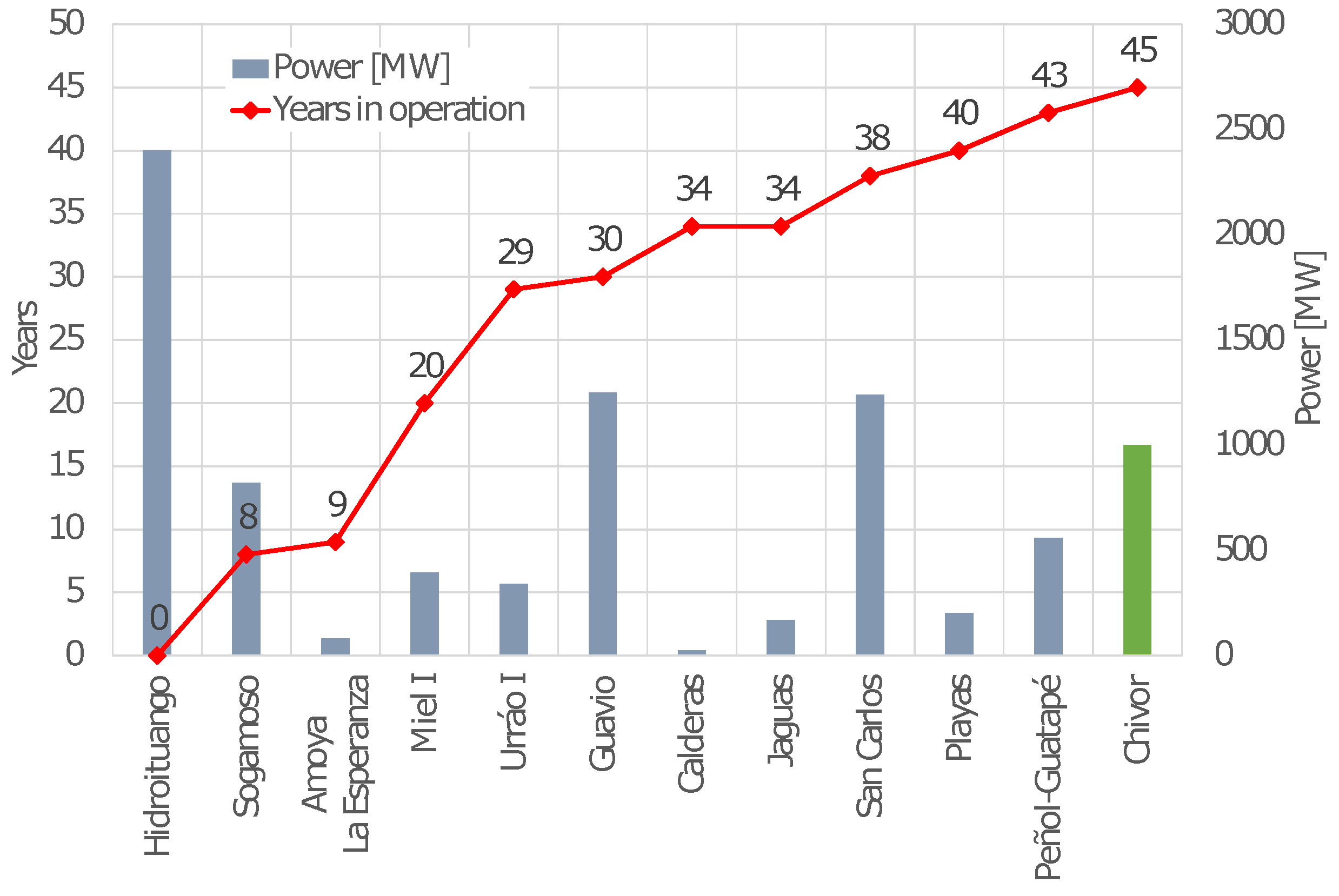
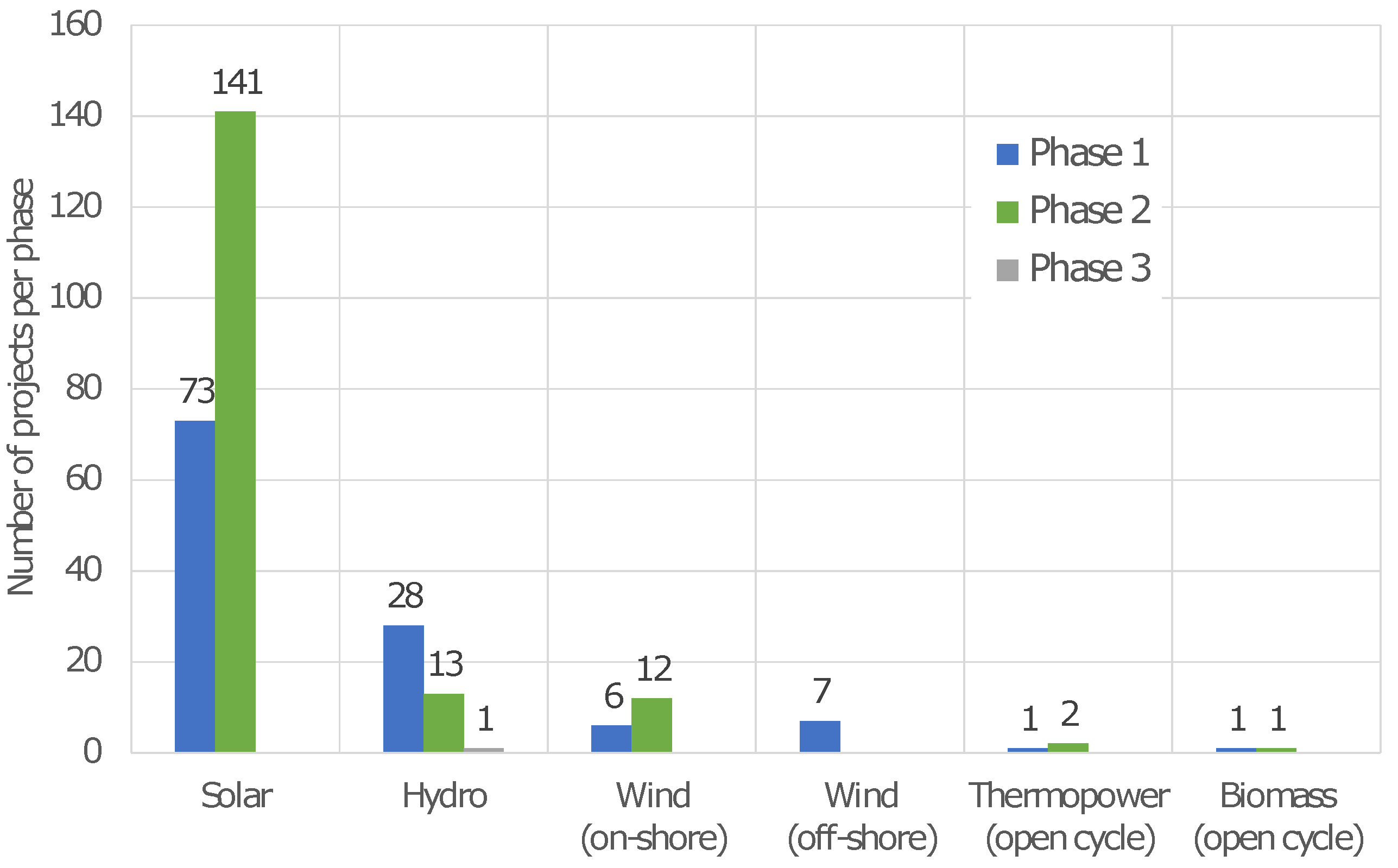



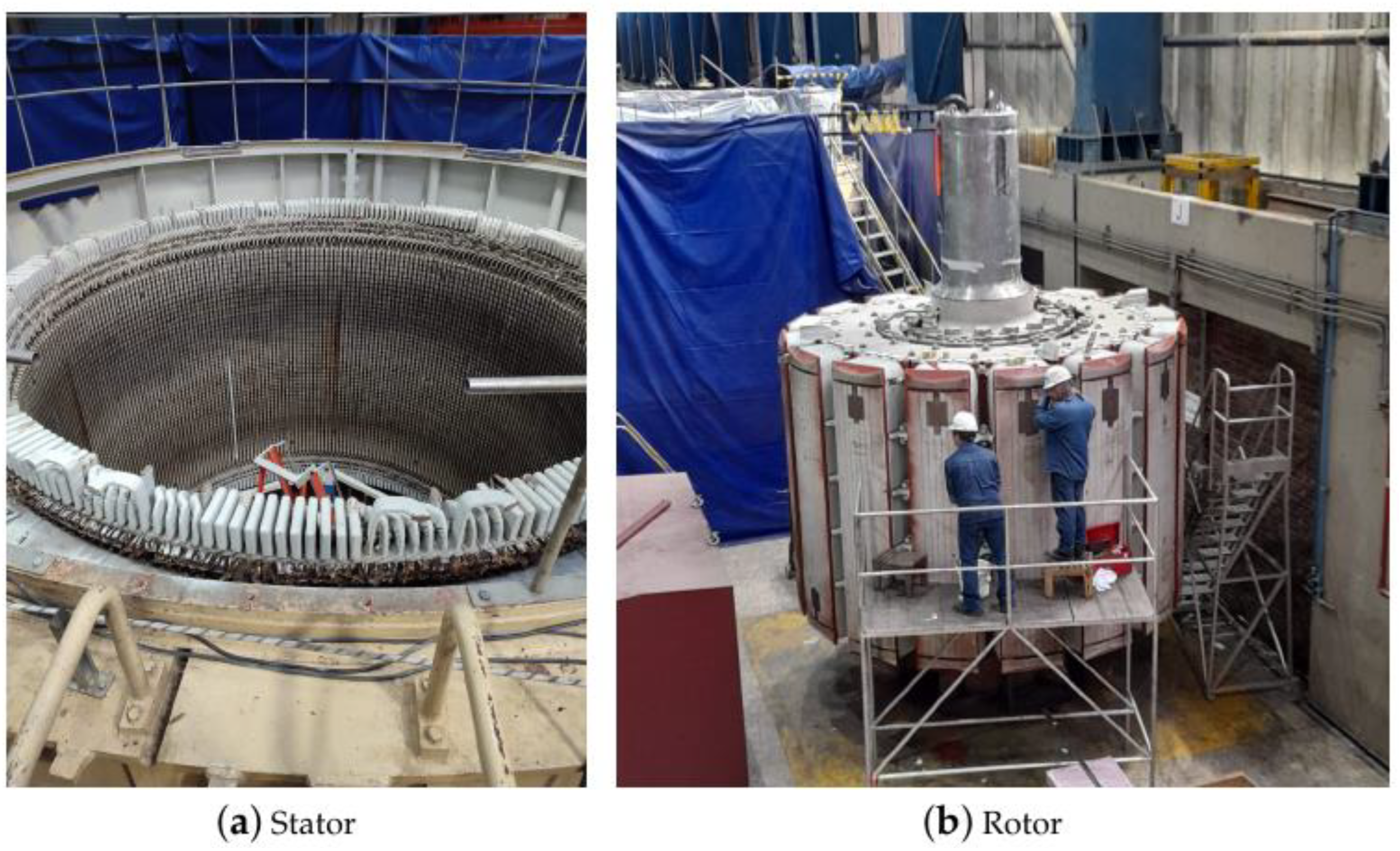
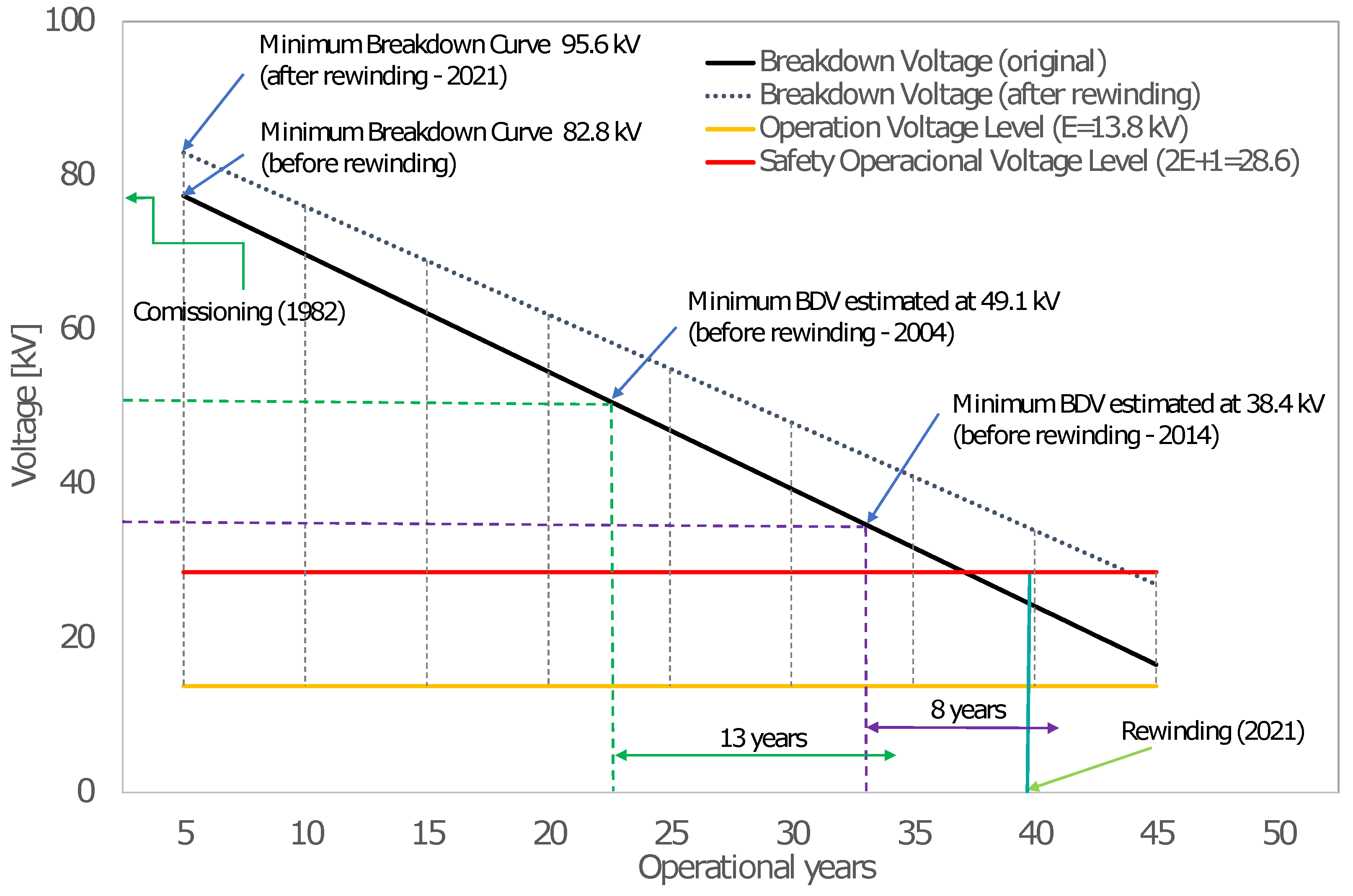

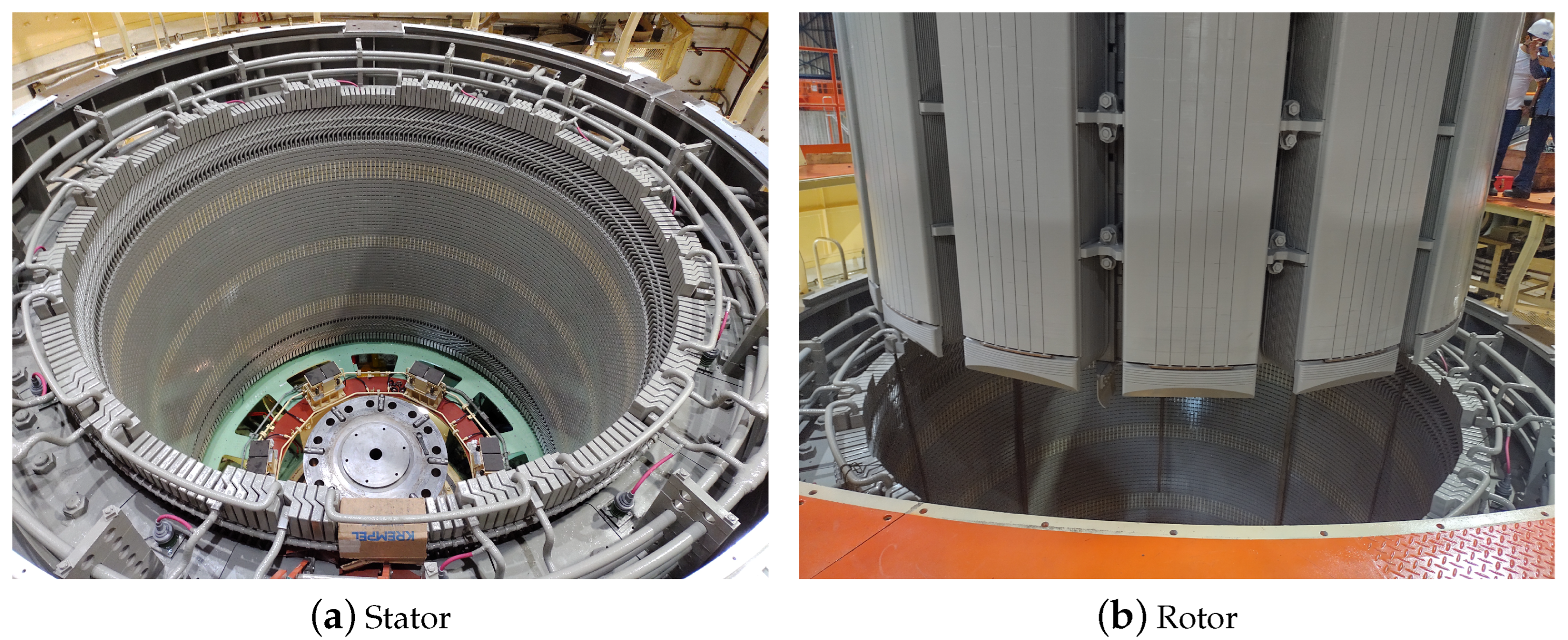
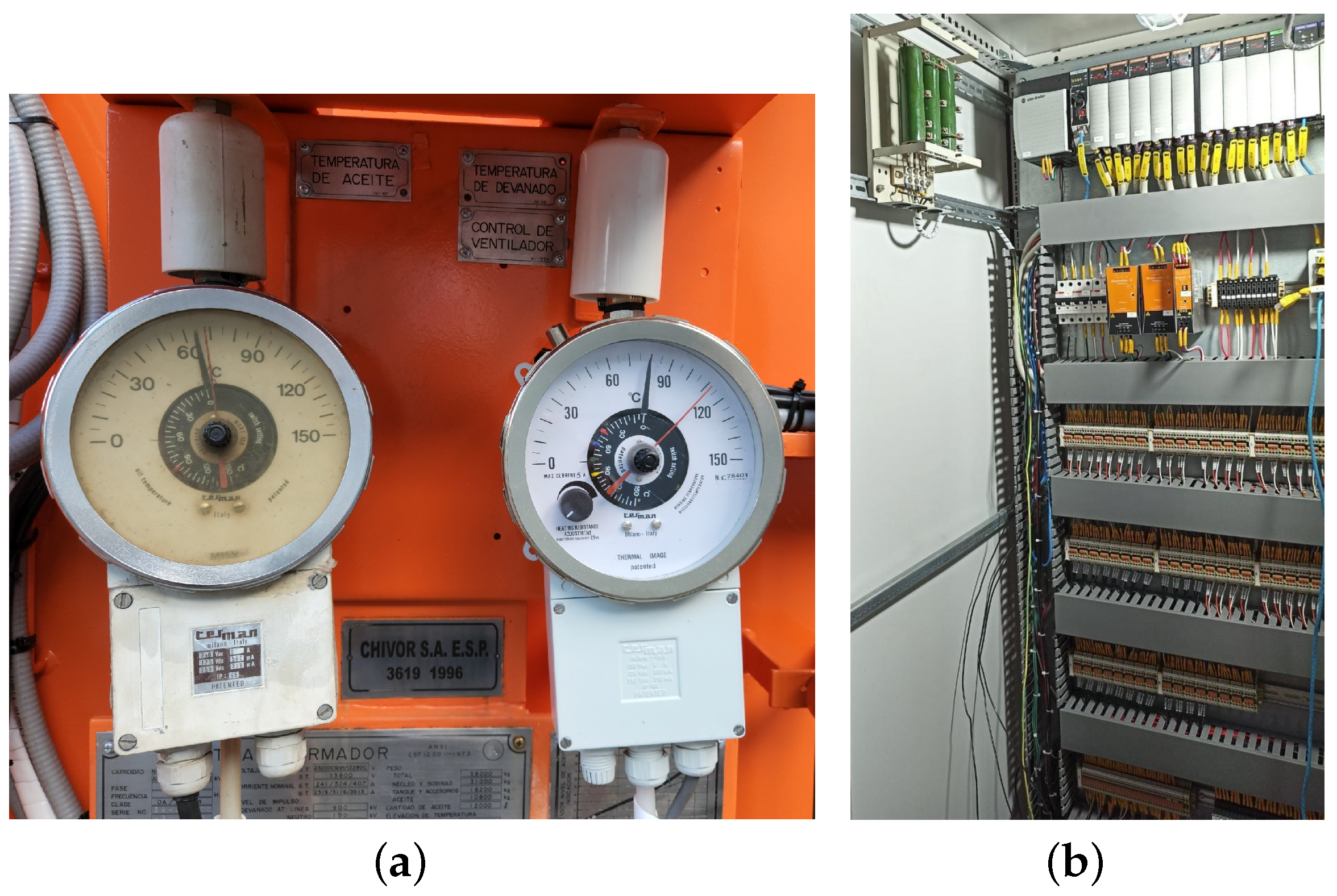
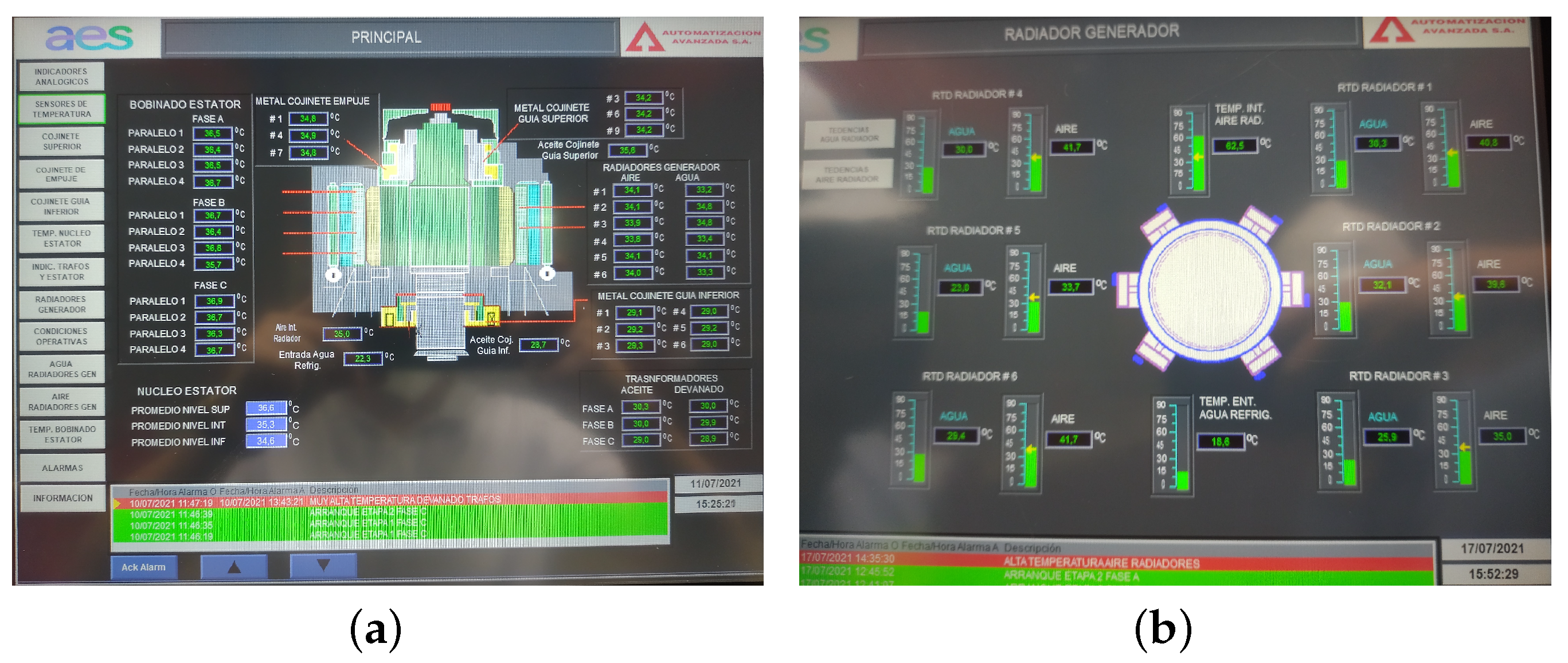
| Parameter | Value |
|---|---|
| Extend the life expectancy | 45–50 years |
| Minimum Breakdown Voltage (before rewinding) | 38.4 kV |
| Minimum Breakdown Voltage (after rewinding) | 95.6 kV |
| Estimated lost cost of a 3 or 6 month failure | 14 to 28 M USD |
Disclaimer/Publisher’s Note: The statements, opinions and data contained in all publications are solely those of the individual author(s) and contributor(s) and not of MDPI and/or the editor(s). MDPI and/or the editor(s) disclaim responsibility for any injury to people or property resulting from any ideas, methods, instructions or products referred to in the content. |
© 2023 by the authors. Licensee MDPI, Basel, Switzerland. This article is an open access article distributed under the terms and conditions of the Creative Commons Attribution (CC BY) license (https://creativecommons.org/licenses/by/4.0/).
Share and Cite
Leguizamon-Perilla, A.; Rodriguez-Bernal, J.S.; Moralez-Cruz, L.; Farfán-Martinez, N.I.; Nieto-Londoño, C.; Vásquez, R.E.; Escudero-Atehortua, A. Digitalisation and Modernisation of Hydropower Operating Facilities to Support the Colombian Energy Mix Flexibility. Energies 2023, 16, 3161. https://doi.org/10.3390/en16073161
Leguizamon-Perilla A, Rodriguez-Bernal JS, Moralez-Cruz L, Farfán-Martinez NI, Nieto-Londoño C, Vásquez RE, Escudero-Atehortua A. Digitalisation and Modernisation of Hydropower Operating Facilities to Support the Colombian Energy Mix Flexibility. Energies. 2023; 16(7):3161. https://doi.org/10.3390/en16073161
Chicago/Turabian StyleLeguizamon-Perilla, Aldemar, Juan S. Rodriguez-Bernal, Laidi Moralez-Cruz, Nidia Isabel Farfán-Martinez, César Nieto-Londoño, Rafael E. Vásquez, and Ana Escudero-Atehortua. 2023. "Digitalisation and Modernisation of Hydropower Operating Facilities to Support the Colombian Energy Mix Flexibility" Energies 16, no. 7: 3161. https://doi.org/10.3390/en16073161
APA StyleLeguizamon-Perilla, A., Rodriguez-Bernal, J. S., Moralez-Cruz, L., Farfán-Martinez, N. I., Nieto-Londoño, C., Vásquez, R. E., & Escudero-Atehortua, A. (2023). Digitalisation and Modernisation of Hydropower Operating Facilities to Support the Colombian Energy Mix Flexibility. Energies, 16(7), 3161. https://doi.org/10.3390/en16073161










